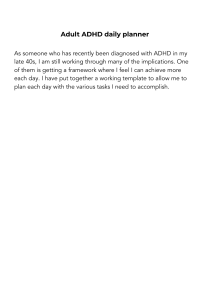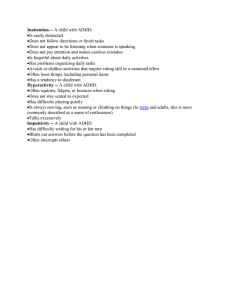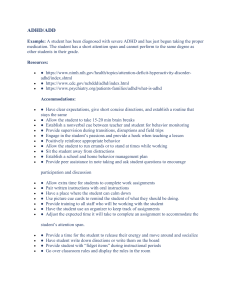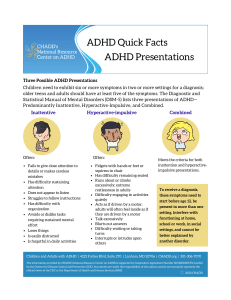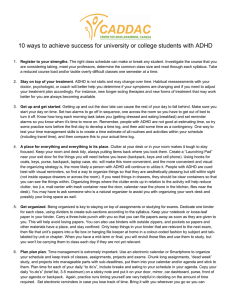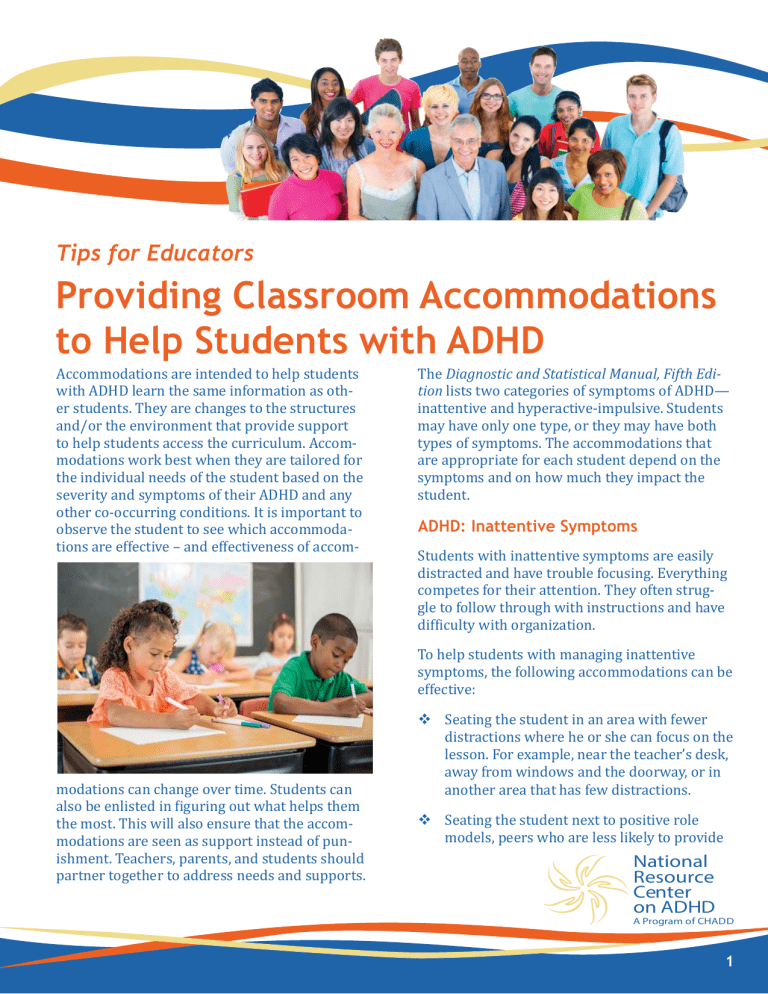
Tips for Educators Providing Classroom Accommodations to Help Students with ADHD Accommodations are intended to help students with ADHD learn the same information as other students. They are changes to the structures and/or the environment that provide support to help students access the curriculum. Accommodations work best when they are tailored for the individual needs of the student based on the severity and symptoms of their ADHD and any other co-occurring conditions. It is important to observe the student to see which accommodations are effective – and effectiveness of accom- The Diagnostic and Statistical Manual, Fifth Edition lists two categories of symptoms of ADHD— inattentive and hyperactive-impulsive. Students may have only one type, or they may have both types of symptoms. The accommodations that are appropriate for each student depend on the symptoms and on how much they impact the student. ADHD: Inattentive Symptoms Students with inattentive symptoms are easily distracted and have trouble focusing. Everything competes for their attention. They often struggle to follow through with instructions and have dif iculty with organization. To help students with managing inattentive symptoms, the following accommodations can be effective: modations can change over time. Students can also be enlisted in iguring out what helps them the most. This will also ensure that the accommodations are seen as support instead of punishment. Teachers, parents, and students should partner together to address needs and supports. Seating the student in an area with fewer distractions where he or she can focus on the lesson. For example, near the teacher’s desk, away from windows and the doorway, or in another area that has few distractions. Seating the student next to positive role models, peers who are less likely to provide National Resource Center on ADHD A Program of CHADD 1 distractions and can help them stay on task. Breaking long assignments into smaller parts. This allows students to see both the start and end of the task. Making sure all assignments are clear and provided in writing in addition to giving them out loud. Checking with the student before they complete an assignment to see if they heard and understood instructions. Ask them to repeat it back to verify understanding. Allowing them to take tests in a different room, one that is quiet and has few distractions. Or using aids such as headphones or privacy boards to create quiet spaces in the classroom. Giving more time to complete assignments, projects, and tests. Using a timer or alarm to help with time management. Providing breaks. Depending on the student, these could include stretching, walking to the board to complete a task, or handing out assignments or materials. Limiting repetitive assignments, particularly those the students has already mastered, or tasks that are too far above the student’s level. Students are most able to pay attention to tasks that present some challenge but are within their current learning zone. Making sure that the student has the opportunity for physical activities because active movement increases the ability to focus. Recess should never be taken away as a punishment for misbehavior. Providing tools to help with organization, such as different colored folders, a notebook with dividers, or a homework assignment book. Using computers or tablets for work. Computers are visually stimulating and allow for more engagement and also help students organize their thoughts. ADHD: Hyperactive-Impulsive Symptoms Students with hyperactive-impulsive symptoms move a lot. They idget, squirm, and have dif iculty staying seated. They often talk excessively, blurt out answers, and have trouble taking turns. To help students manage their hyperactive-impulsive symptoms, the following accommodations can be effective: Seating the student in an area of the room where there will be the least disruption. This might be towards either side of the classroom rather than the center. Allowing for the student to move around. You could allow the student to do their work while standing, sitting on the loor, or moving between desks. 2 Sample Behaviors Constantly moving in their seat Attention wavers, but when focused blurts out answers Has trouble completing assignments and tests in the allotted time because of distractions Taps a pen constantly that is distracting to other students Pairing the student with a peer who is a good role model and can model appropriate behavior. Providing activity breaks. Depending on the student, these could include stretching, walking to the board to complete a task, or handing out assignments or materials. Ignoring minor misbehavior. Allowing the student to move or idget in a non-distracting manner. They might tap their foot in the air or rotate their pen back and forth in their hands. Asking the student to offer suggestions is always a great way to get more ideas. Allowing them to take tests in a different room. One that is quiet, has few distractions, and lets them move around without interrupting other students. Accommodations Try giving them options for how they can do their work and provide breaks. Try consistent praise for raising their hands and seating them in an area with minimal distractions. Try an alternative test setting or breaking up assignments and tests into smaller sections. Allow extra time to complete tests. Let the student know privately that tapping their pen is a distraction. Ask them if they have other suggestion for how they could focus. You might offer that they could wave their pen in the air, wiggle it between their fingers, or replace the pen with a soft object to tap that won’t make noise. Limiting repetitive assignments, particularly those the students has already mastered, or tasks that are too far above the student’s level. Fidgeting is often a symptom of boredom or overstimulation. Making sure that the student has the opportunity for physical activities. Recess should never be taken away as a punishment for misbehavior. Using a speaking stick or other object that gets passed around during class discussions as a cue to indicate whose turn it is to speak. ADHD: combined symptoms Many students with ADHD show a combination of inattention and hyperactive-impulsive behaviors. You can use a combination of accommodations from both lists. One of the best ways to identify which accommodations might work best is to observe the student’s natural behavior. Praising when they exhibit appropriate behavior such as raising their hands and waiting to be called. 3 Help with social challenges Besides creating academic challenges, ADHD also affects social skills. Student may have trouble controlling their emotions, and younger kids especially may have difficulty keeping their hands to themselves. They might not interpret social cues effectively. They could also struggle with conversational skills. These challenges often cause students with ADHD to have difficulty making and keeping friends. As a teacher, you can help by providing a positive learning environment. You can also teach, show, and support appropriate behavior in the following ways: Praise the student for good behavior more often than punishing for bad. Give encouragement and reassurance. Let the student hear they are succeeding. Frequent but brief feedback that lets the student know they are on the right track is often very effective. Provide opportunities for other students to see them in a positive light. You might ask the student to help you with a task or give him or her a leadership role in the classroom for a day―anything to help the student feel connected to the classroom and the school. Provide feedback in one-on-one settings. Not only do you preserve self-esteem by providing feedback privately, but you also can help reinforce positive behavior and have the student practice having a conversation with you to improve social skills. References Barkley, R. (2008). Classroom Accommodations for Children with ADHD. ADHD Report. Dendy, C., Durheim, M., & Ellison, A. (2006). CHADD Educator’s Manual. Lynchburg, VA: Progress Printing. Work with students to set up a private signal, either visually or verbally, to help them recognize when their behavior is bordering on inappropriate. When prompting behavior you want it to be a reminder rather than a reprimand. Parker, H. (2012). Accommodations Help Students with Attention De icit Disorders. A.D.D. WareHouse. Promote self-awareness. Ask students to describe the problem or issue they are having. Ask them why they think it is happening and how they can change their behavior. Chaban, P., McAuley, T., & Tannock, R. (2009). ADHD and Social-Emotional Abilities. www. AboutKidsHealth.ca. Zentall, S. (2006). ADHD and Education Foundations, Characteristics, Methods, and Collaboration. Upper Saddle River, NJ: Pearson Education. Give opportunities for group or paired learning. The opportunities provide a structured setting for students to interact with classmates. For further information, please contact: National Resource Center on ADHD: A Program of CHADD 4601 Presidents Drive, Suite 300 Lanham, MD 20706-4832 1-800-233-4050 www.chadd.org/nrc © 2016 Children and Adults with Attention-Deficit/ Hyperactivity Disorder (CHADD). All Rights Reserved. This factsheet is supported by Cooperative Agreement Number NU38DD005376 from the Centers for Disease Control and Prevention (CDC). The contents are solely the responsibility of the authors and do not necessarily represent the official views of CDC. Permission is granted to photocopy and freely distribute this factsheet for non-commercial, educational purposes only, provided that it is reproduced in its entirety, including the CHADD and NRC names, logos and contact information.
